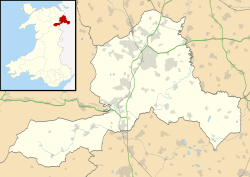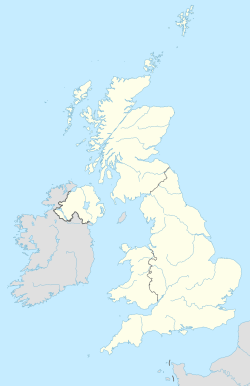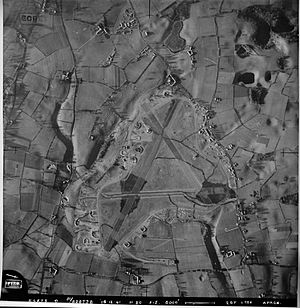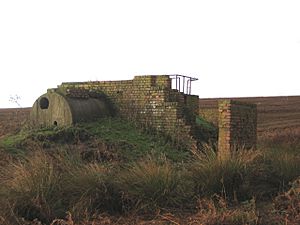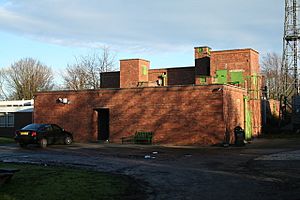RAF Wrexham facts for kids
Quick facts for kids RAF Wrexham
|
|||||||||||
|---|---|---|---|---|---|---|---|---|---|---|---|
| Borras, Wrexham County Borough in Wales | |||||||||||
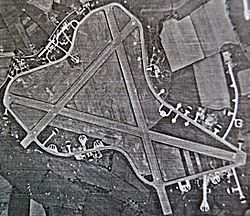 |
|||||||||||
|
Shown within Wrexham
|
|||||||||||
| Coordinates | 53°04′00″N 2°57′01″W / 53.0668°N 2.9504°W | ||||||||||
| Type | Royal Air Force station | ||||||||||
| Code | RW | ||||||||||
| Site information | |||||||||||
| Owner | Air Ministry | ||||||||||
| Operator | Royal Air Force | ||||||||||
| Controlled by | RAF Fighter Command 1941-43 * No. 9 Group RAF RAF Flying Training Command * No. 21 Group RAF |
||||||||||
| Site history | |||||||||||
| Built | 1917 & 1940/41 | ||||||||||
| Built by | (1941) Sir Alfred McAlpine Ltd | ||||||||||
| In use | 1917-1920 June 1941 - 1945 |
||||||||||
| Battles/wars | European theatre of World War II * Battle of Britain * Defence of Liverpool Cold War |
||||||||||
| Airfield information | |||||||||||
| Elevation | 67 metres (220 ft) AMSL | ||||||||||
|
|||||||||||
Royal Air Force Wrexham, or RAF Wrexham, was a special airport used by the Royal Air Force (RAF). It was located in Borras, a place near Wrexham, Wales. This airfield played an important role in both the First and Second World Wars.
First, it was a local airport. Then, the Royal Flying Corps used it during the First World War. Later, the Royal Air Force used it in the Second World War. After the wars, during the Cold War, it became a secret bunker for watching for nuclear attacks.
Contents
A Look Back: The History of RAF Wrexham
Early Flights and Air Displays
The story of flying in Wrexham began in 1912. A famous pilot named Gustav Hamel visited the Racecourse Ground. He put on amazing air shows for everyone to watch. People even talked about turning the racecourse into a proper airport.
Between 1917 and 1920, fields at Borras Lodge were used for training pilots. Squadrons from the Royal Flying Corps and later the Royal Air Force practiced here. In the 1930s, local flying clubs also used the site for air displays. Even famous aviator Sir Alan Cobham brought his flying circus to Wrexham twice!
RAF Wrexham During World War II
RAF Wrexham was built on a high, dry area. This was great because other airfields nearby often got muddy. Because it was dry, many training planes, like Supermarine Spitfires, would come to Wrexham to practice. In 1940, it had three grass runways. Sometimes, planes would land here when other airfields were too wet, even though Wrexham didn't have air traffic control at first. This led to a few small accidents.
The main building work happened from late 1940 to mid-1941. They built strong concrete runways and added lights for night flying. The nearby Royal Ordnance Factory had defenses, which also helped protect the airfield. RAF Wrexham was mainly set up to host night fighter planes. These planes would protect cities like Liverpool and Manchester from enemy attacks at night. In 1941, No. 96 Squadron RAF, a night fighter group, moved to Wrexham.
The airfield was also home to No. 285 Squadron. This squadron used special planes called Target tugs. These planes would pull targets through the air for other pilots to practice shooting at. They used planes like Bristol Blenheims and Lockheed Hudsons. This squadron was later closed in 1945.
To the west of the airfield, on Esclusham Mountain, there was a "decoy" airfield. This was a fake airfield built to trick enemy bombers. It was only used from 1941 to 1943. However, the mountain was bombed several times by planes dropping fire bombs. This caused big mountain fires. The German pilots thought these fires were from a burning Liverpool, so they kept bombing the area.
Many different RAF units used RAF Wrexham during the war for training and other operations.
US Army Air Strips
During World War II, the US Army also used small landing spots at RAF Wrexham. These were called "cubstrips." They were simple areas where small planes, like Piper Cubs, could land. These planes helped support US Army groups staying in local houses, like Acton Hall. There were no special buildings or paved surfaces at these cubstrips. Besides the one on the airfield, there were four others nearby. They were used by different US Army divisions. These small landing spots were only used for about a year.
What Happened After the RAF Left
RAF Wrexham closed down in 1945. In 1959, it was sold to a company that deals with gravel. In the 1970s, they started digging for gravel and stone in the area. This has changed the site a lot. Even in 2004, you could still see parts of the original runway and its paint in some places.
The site is also known as Borras Airfield. In 1977, a big Welsh festival called the National Eisteddfod of Wales was held on the old airfield.
In 2005, the quarry company wanted to dig even more. An archaeological study found that some original buildings were still there. These included a Bellman hangar (a type of aircraft shelter) and brick buildings used for target practice. There are also places where planes crashed in the area, like a Bristol Beaufighter that fell into a pond.
Cold War Secrets: The Nuclear Bunker
From 1962 to 1992, a strong, underground nuclear bunker was built at RAF Wrexham. This bunker was for the Royal Observer Corps. Their job was to watch for enemy attacks and nuclear fallout. If a war happened, they would have sounded the "four-minute warning" alarm. This would tell people in Wrexham that a nuclear attack was coming. They would also warn about dangerous radioactive fallout.
Up to 80 volunteers worked in the bunker. They trained every week and wore uniforms like the Royal Air Force. After the Cold War ended around 1989, the Royal Observer Corps was closed down. But the nuclear bunker is still there at RAF Wrexham. It reminds us of the Cold War. Today, it has been changed and is used as a recording studio!
See also
- List of former Royal Air Force stations


